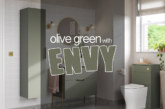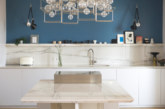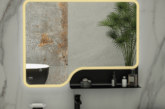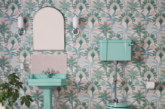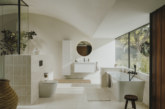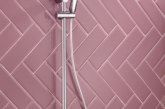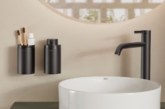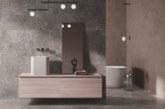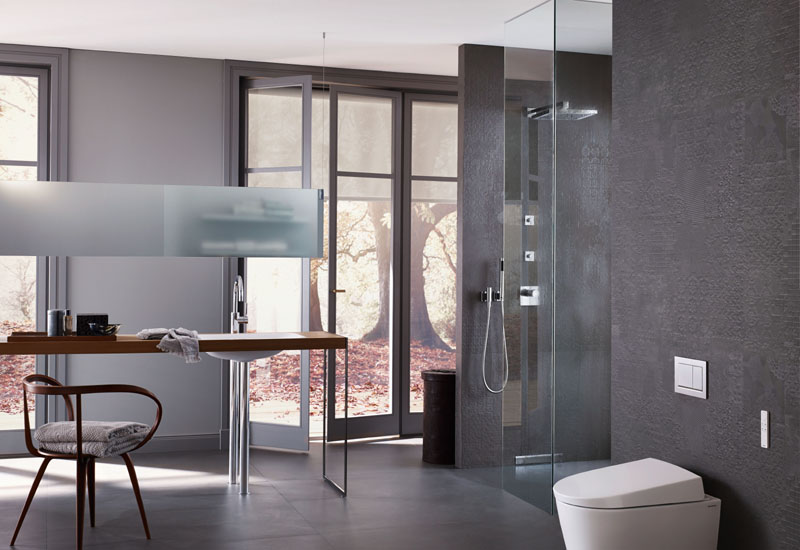
With the latest water-saving solutions for the bathroom, cutting down on water wastage in line with building regulation requirements is as simple as turning on a tap. Peter Davis, Head of Product Management – Sanitary & Ceramics at Geberit, looks at some of the options available to house builders and developers.
Building houses that help conserve water rather than wasting it is key for developers, particularly in order to adhere to Part G2 of the Building Regulations for water efficiency. Since 2010, regulations have stipulated that every new house ‘must not exceed the minimum water efficiency requirement for new dwellings, namely a potential consumption of water of not more than 125 litres per person, per day’. The onus is therefore on the house builder to source fixtures and fittings that help meet these requirements, without compromising on performance or user comfort.
Flush away
With each of us flushing the toilet an average of 5.2 times a day, and a third of a household’s total water usage being flushed away, developers can make significant water savings by specifying dual flush cisterns. In fact, choosing this option can reduce the amount of water used per household by as much as 40 per cent, compared to an old style, close-coupled cistern with lever action which would have been installed in many houses post-2010. To give this 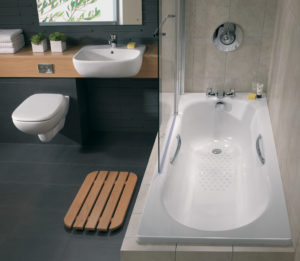 percentage a little more perspective, a cistern that uses a maximum 4.5 litres of water per flush reduces the average amount of water used per year by more than 2,800 litres. This amount increases to as much as 5,840 litres when toilets are flushed at the lower water volume of three litres, which many cisterns are now able to offer.
percentage a little more perspective, a cistern that uses a maximum 4.5 litres of water per flush reduces the average amount of water used per year by more than 2,800 litres. This amount increases to as much as 5,840 litres when toilets are flushed at the lower water volume of three litres, which many cisterns are now able to offer.
The good news gets better too, as this effective water-saving solution is far from difficult to fit or integrate in to the design of the bathroom or cloakroom. A dual flush cistern, incorporated into the frame behind the wall on wall-hung sanitaryware is no more difficult to install than its floor-standing alternative, yet leaves a seamless, high-end finish behind.
Geberit Duofix frame systems incorporate a dual flush cistern as standard, with a range of solutions available to suit all requirements. The Geberit Sigma concealed cistern has a specially adapted flush valve, which can operate at a low flush volume of 4.5 or 3 litres when coupled with a matching ceramic standard. This results in up to 3,000 litres of water being saved per year with a standard cistern flush, and as much as 6,000 litres a year when flushing at its very lowest volume.
Wash your hands of it
Bathroom brassware chosen for new homes can also have a big impact on the amount of water used by the household on a daily basis, with routine activities such as showering, hand washing and teeth brushing all adding up by the end of the day. Leaving the tap running while brushing teeth uses around 12-15 litres of water, according to Waterwise, while between three and nine litres of water are used each time anyone washes their hands.
Mixer taps and showers with water-saving features built-in can therefore help reduce wastage substantially. Brassware which enables the user to have a certain amount of control over how much water they need offers house builders the best of both worlds.
The Twyford X52 low flow basin mixers limits the flow rate to 4 litres per minute and to 6 litres in the bath shower mixers. Complying with BREEAM:Wat1 assessment criteria, the mixer taps delivers water at 4 litres per minute with one click back and 7 litres per minute with two clicks. This enables the user to choose the flow rate depending on the activity being carried out and the amount of water required.
Shower vs bath
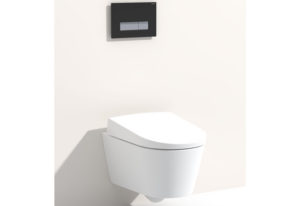 The perception that showers use less water than baths is not entirely accurate, and house builders would therefore be unwise to forsake the luxury of a bath within their bathroom designs in favour of a shower simply in the name of water-saving. A standard bathtub can hold around 170 litres of water, while a conventional electric shower uses around 90 litres of water in a typical eight-minute ablution. However, an eight-minute power shower uses around 160 litres of water, which is not that much less than an average bath.
The perception that showers use less water than baths is not entirely accurate, and house builders would therefore be unwise to forsake the luxury of a bath within their bathroom designs in favour of a shower simply in the name of water-saving. A standard bathtub can hold around 170 litres of water, while a conventional electric shower uses around 90 litres of water in a typical eight-minute ablution. However, an eight-minute power shower uses around 160 litres of water, which is not that much less than an average bath.
The company’s Opal and Celtic baths have capacities of 130 litres and 140 litres, while still offering a luxurious bathing experience for the user. The manufacturer’s Celtic Low Volume 1700mm bath has a capacity of 140 litres to the overflow, while still offering the benefits of a standard steel bath. That is an estimated 35 per cent water saving compared to a standard bath.
The trick for house builders is to source fixtures and fittings for the bathroom that are aesthetically pleasing as well as water saving, keeping in line with building regulations and keeping home buyers happy.

